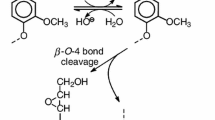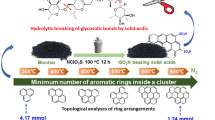Abstract
Degradation of fermentable monosaccharides is one of the primary concerns for acid prehydrolysis of lignocellulosic biomass. Recently, in our research on degradation of pure monosaccharides in aqueous SO2 solution by gas chromatography (GC) analysis, we found that detected yield was not actual yield of each monosaccharide due to the existence of sugar–bisulfite adducts, and a new method was developed by ourselves which led to accurate detection of recovery yield of each monosaccharide in aqueous SO2 solution by GC analysis. By the use of this method, degradation of each monosaccharide in aqueous SO2 was investigated and results showed that sugar–bisulfite adducts have different inhibiting effect on degradation of each monosaccharide in aqueous SO2 because of their different stability. In addition, NMR testing also demonstrated possible existence of reaction between conjugated based HSO3 − and aldehyde group of sugars in acid system.








Similar content being viewed by others
References
Tian, S., Zhu, W., Gleisner, R., Pan, X. J., & Zhu, J. Y. (2011). Biotechnol Progress, 29, 419–427.
Shi, Y., Yokoyama, T., Matsumoto, Y. (2011). In: Proceedings of the 56 th lignin Symposium, Tsuruoka, Japan, pp.58-61.
Shi, Y., Yokoyama, T., Matsumoto, Y. (2010), In: 4 th International Symposium on Emerging Technologies of Pulping and Papermaking, Guangzhou, China, pp.1353-1356.
Yu, J. L., Zhong, J., Zhang, X., & Tan, T. W. (2010). Applied Biochemistry and Biotechnology, 160, 401–409.
Shi, Y., Yokoyama, T., Akiyama, T., Yashiro, M., & Matsumoto, Y. (2012). BioResources, 7, 4085–4097.
Shi, Y., Yokoyama, T., Akiyama, T., Yashiro, M., & Matsumoto, Y. (2013). BioResources, 8, 4837–4848.
Zhu, J. Y., Pan, X. J., Wang, G. S., & Gleisner, R. (2009). Bioresource Technology, 100, 2411–2418.
Wang, G. S., Pan, X. J., & Zhu, J. Y. (2009). Biotechnol Progress, 25, 1086–1093.
Thomas, M. D., Hendrikcks, R. H., & Hill, R. (1944). Plant Physiology, 19, 212–216.
Brauns, F. E., & Brown, D. S. (1938). Industrial and Engineering Chemistry, 30, 779–781.
Katritzky, A. R., Meth-Cohn, O., Rees, C. W. (1995), Comprehensive organic functional group transformations. Eds.; Elsevier Science Ltd.: New York, 4, pp. 967.
Stewart, G. F. (1995). Nature of the sugar-bisulfite addition compounds. Advance in Food Research, 6, 389.
Brown, H. H. (1944). The Journal of Organic Chemistry, 9, 477–483.
Daintith, J. (2004). Sugar bisulfite addition compound. The facts on file dictionary of organic chemistry. ISBN 0-8160-4928-9, Facts On File, Inc: New York, pp.11.
Braverman, J. B. S. (1953). Journal of the Science of Food and Agriculture, 4, 540–547.
Braverman, J.B.S (1960) J Food BioTechnol, 248–252.
Voegele, A. F., Tautermann, C. S., Loerting, T., Hallbrucker, A., Mayer, E., & Liedl, K. R. (2002). Chem A European J, 8, 5644–5651.
Nursten, H. E. (1998). Royal Society of Chemistry (Great Britain), 155–158.
Castantilde, H. O., Contreras, E., & de Kowalewski, D. G. (1980). Org Magn. Resonance., 13, 308–309.
Acknowledgments
I would like to gratefully and sincerely thank the Japanese Government for providing Japanese Monbu-Kagakusho scholarship which enabled me to absorbedly dive into my research at the Wood Chemistry Lab of Graduate School of Agricultural and Life Sciences in the University of Tokyo. This study was also funded by the Tianjin Research Program of Application Foundation and Advanced Technology (no. 13JCYBJC38800).
Author information
Authors and Affiliations
Corresponding author
Rights and permissions
About this article
Cite this article
Shi, Y. Existence of the Sugar–Bisulfite Adducts and Its Inhibiting Effect on Degradation of Monosaccharide in Acid System. Appl Biochem Biotechnol 172, 1612–1622 (2014). https://doi.org/10.1007/s12010-013-0577-4
Received:
Accepted:
Published:
Issue Date:
DOI: https://doi.org/10.1007/s12010-013-0577-4




